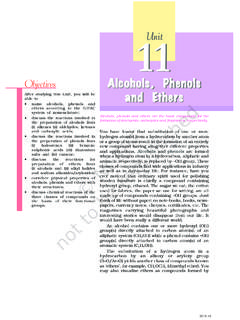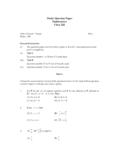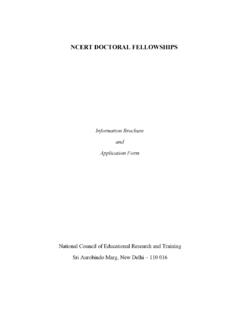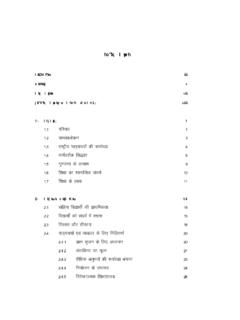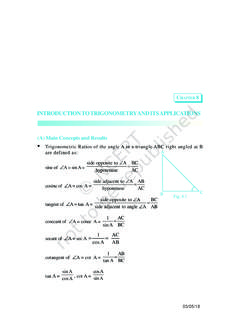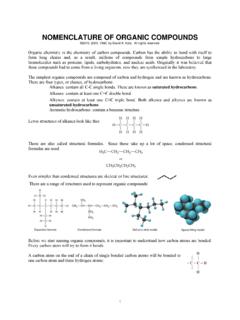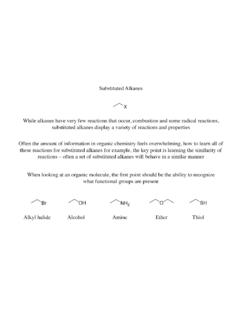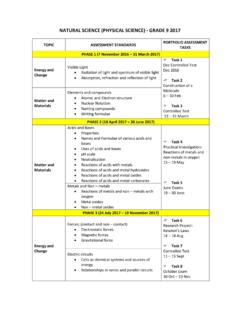Transcription of 12 UnitUnitUnit
1 After studying this Unit, you will beable to write the common and IUPAC names of aldehydes, ketones andcarboxylic acids; write the structures of thecompounds containing functionalgroups namely carbonyl andcarboxyl groups; describe the important methodsof preparation and reactions ofthese classes of compounds; correlate physical properties andchemical reactions of aldehydes,ketones and carboxylic acids,with their structures; explain the mechanism of a fewselected reactions of aldehydesand ketones; understand various factorsaffecting the acidity of carboxylicacids and their reactions; describe the uses of aldehydes,ketones and carboxylic compounds are of utmost importance to organicchemistry.
2 They are constituents of fabrics, flavourings, plasticsand , K, K, K, K, Keeeeetonestonestonestonestonesand Carboxylicand Carboxylicand Carboxylicand Carboxylicand CarboxylicAAAAA cidscidscidscidscidsAldehydesAldehydesAl dehydesAldehydesAldehydes, K, K, K, K, Keeeeetonestonestonestonestonesand Carboxylicand Carboxylicand Carboxylicand Carboxylicand CarboxylicAAAAA cidscidscidscidscidsIn the previous Unit, you have studied organiccompounds with functional groups containing carbon-oxygen single bond. In this Unit, we will study about theorganic compounds containing carbon-oxygen doublebond (>C=O) called carbonyl group, which is one of themost important functional groups in organic aldehydes, the carbonyl group is bonded to acarbon and hydrogen while in the ketones, it is bondedto two carbon atoms.
3 The carbonyl compounds in whichcarbonyl group is bonded to oxygen are known ascarboxylic acids, and their derivatives ( esters,anhydrides) while in compounds where carbon isattached to nitrogen and to halogens are called amidesand acyl halides respectively. The general formulas ofthese classes of compounds are given below:2015-16350 ChemistryAldehydes, ketones and carboxylic acids are widespread in plantsand animal kingdom. They play an important role in biochemicalprocesses of life. They add fragrance and flavour to nature, for example,vanillin (from vanilla beans), salicylaldehyde (from meadow sweet) andcinnamaldehyde (from cinnamon) have very pleasant and ketonesAldehydes and ketones are the simplest and most important are two systems of nomenclature of aldehydes and ketones.
4 (a)Common namesAldehydes and ketones are often called by their common namesinstead of IUPAC names. The common names of most aldehydes arederived from the common names of the corresponding carboxylicacids [Section ] by replacing the ending ic of acid with the same time, the names reflect the Latin or Greek term for theoriginal source of the acid or aldehyde. The location of the substituentin the carbon chain is indicated by Greek letters , , , , etc. The -carbon being the one directly linked to the aldehyde group, -carbon the next, and so on. For and Structure of Carbonyl GroupNomenclature and Structure of Carbonyl GroupNomenclature and Structure of Carbonyl GroupNomenclature and Structure of Carbonyl GroupNomenclature and Structure of Carbonyl GroupThey are used in many food products and pharmaceuticals to addflavours.
5 Some of these families are manufactured for use as solvents( , acetone) and for preparing materials like adhesives, paints, resins,perfumes, plastics, fabrics, , Ketones and Carboxylic AcidsThe common names of ketones are derived by naming two alkylor aryl groups bonded to the carbonyl group. The locations ofsubstituents are indicated by Greek letters, , and so onbeginning with the carbon atoms next to the carbonyl group,indicated as . Some ketones have historical common names,the simplest dimethyl ketone is called acetone. Alkyl phenylketones are usually named by adding the acyl group as prefix tophenone. For example(b)IUPAC namesThe IUPAC names of open chain aliphatic aldehydes and ketonesare derived from the names of the corresponding alkanes byreplacing the ending e with al and one respectively.
6 In case ofaldehydes the longest carbon chain is numbered starting from thecarbon of the aldehyde group while in case of ketones thenumbering begins from the end nearer to the carbonyl group. Thesubstituents are prefixed in alphabetical order along with numeralsindicating their positions in the carbon chain. The same applies tocyclic ketones, where the carbonyl carbon is numbered one. Whenthe aldehyde group is attached to a ring, the suffix carbaldehydeis added after the full name of the cycloalkane. The numbering ofthe ring carbon atoms start from the carbon atom attached to thealdehyde group. The name of the simplest aromatic aldehydecarrying the aldehyde group on a benzene ring isbenzenecarbaldehyde. However, the common name benzaldehydeis also accepted by IUPAC.
7 Other aromatic aldehydes are hencenamed as substituted (CH3)2 CHCHOI sobutyraldehyde2-Methylpropanal -Methylcyclohexanecarbaldehyde3-Methylcy clohexanecarbaldehydeCH3CH(OCH3)CHO -Methoxypropionaldehyde2-Methoxypropanal CH3CH2CH2CH2 CHOV aleraldehydePentanalCH2=CHCHOA croleinProp-2-enalPhthaldehydeBenzene-1, 2-dicarbaldehydem-Bromobenzaldehyde 3-BromobenzaldehydeKetonesCH3 COCH2CH2CH3 Methyl n-propyl ketonePentan-2-one(CH3)2 CHCOCH(CH3)2 Diisopropyl ketone2,4-Dimethylpentan-3-one -Methylcyclohexanone2-Methylcyclohexanon e(CH3)2C=CHCOCH3 Mesityl oxide4-Methylpent-3-en-2-oneTable : Common and IUPAC Names of Some Aldehydes and KetonesStructureCommon nameIUPAC nameThe common and IUPAC names of some aldehydes and ketones aregiven in Table , Ketones and Carboxylic AcidsThe carbonyl carbon atom is sp2-hybridised and forms three sigma ( )bonds.
8 The fourth valence electron of carbon remains in its p-orbitaland forms a -bond with oxygen by overlap with p-orbital of an addition, the oxygen atom also has two non bonding electron , the carbonyl carbon and the three atoms attached to it lie in thesame plane and the -electron cloud is above and below this plane. Thebond angles are approximately 120 as expected of a trigonal coplanarstructure (Figure ). Structureof theCarbonylGroup Orbital diagram for the formation of carbonyl groupThe carbon-oxygen double bond is polarised due to higherelectronegativity of oxygen relative to carbon. Hence, the carbonylcarbon is an electrophilic (Lewis acid ), and carbonyloxygen, a nucleophilic (Lewis base) centre. Carbonylcompounds have substantial dipole moments and arepolar than ethers.
9 The high polarity of the carbonyl groupis explained on the basis of resonance involving a neutral(A) and a dipolar (B) structures as QuestionsIntext QuestionsIntext QuestionsIntext QuestionsIntext the structures of the following compounds.(i) -Methoxypropionaldehyde(ii)3-Hydroxybuta nal(iii)2-Hydroxycyclopentane carbaldehyde(iv)4-Oxopentanal(v)Di-sec. butyl ketone(vi)4-FluoroacetophenoneSome important methods for the preparation of aldehydesand ketones are as oxidation of alcoholsAldehydes and ketones are generally prepared by oxidation of primaryand secondary alcohols, respectively (Unit 11, Class XII). dehydrogenation of alcoholsThis method is suitable for volatile alcohols and is of industrialapplication. In this method alcohol vapours are passed over heavymetal catalysts (Ag or Cu).
10 Primary and secondary alcohols givealdehydes and ketones, respectively (Unit 11, Class XII). hydrocarbons(i)By ozonolysis of alkenes: As we know, ozonolysis of alkenesfollowed by reaction with zinc dust and water gives aldehydes, of AldehydesPreparation of AldehydesPreparation of AldehydesPreparation of AldehydesPreparation of Aldehydesand Ketonesand Ketonesand Ketonesand Ketonesand Ketones2015-16354 Chemistryketones or a mixture of both depending on the substitutionpattern of the alkene (Unit 13, Class XI).(ii)By hydration of alkynes: Addition of water to ethyne in thepresence of H2SO4 and HgSO4 gives acetaldehyde. All otheralkynes give ketones in this reaction (Unit 13, Class XI). acyl chloride ( acid chloride)Acyl chloride ( acid chloride) is hydrogenated over catalyst, palladiumon barium sulphate.
